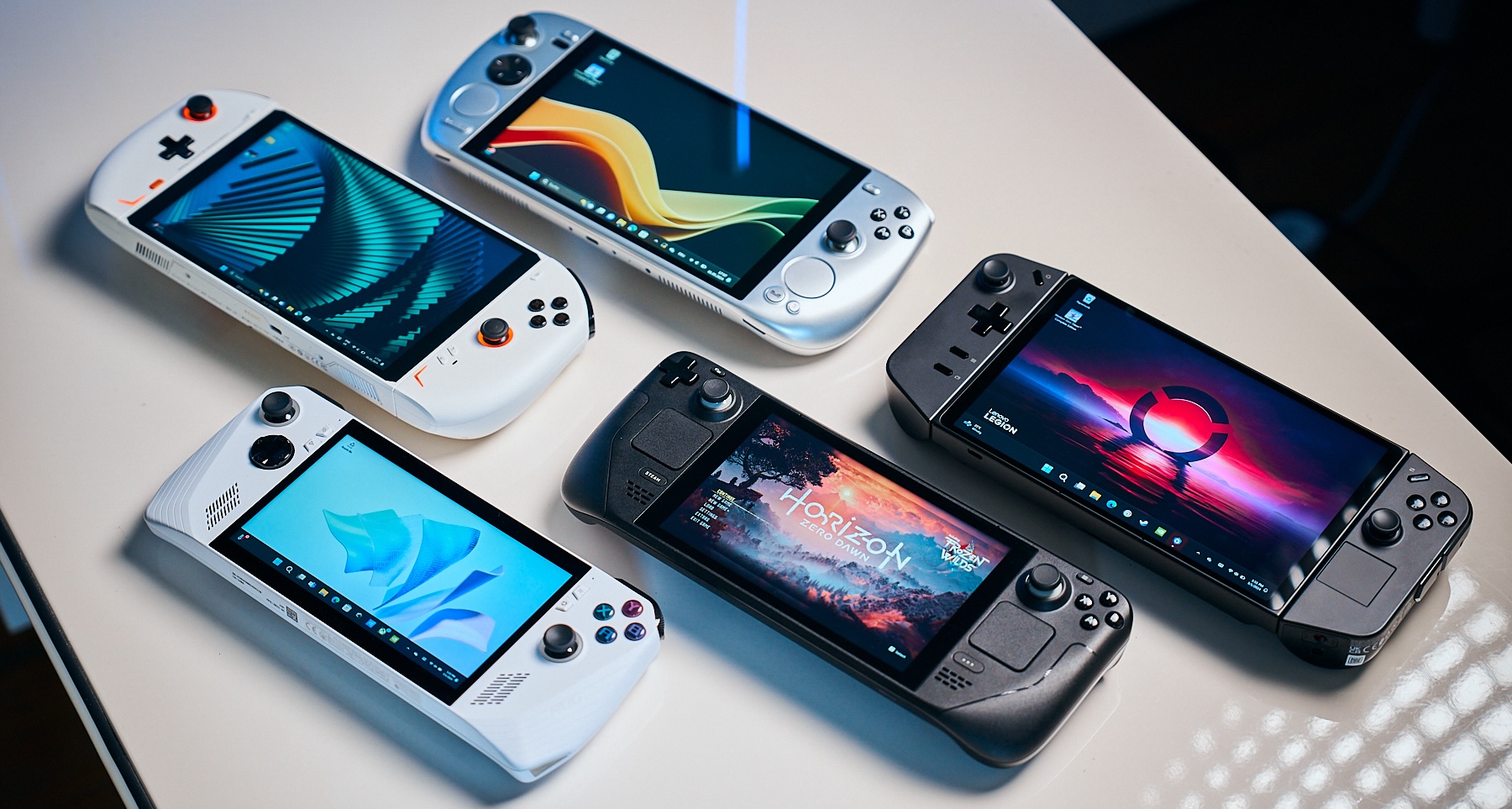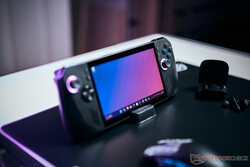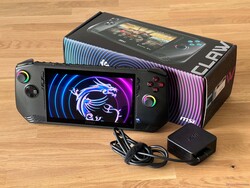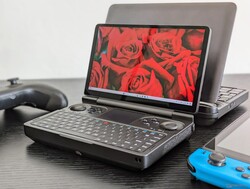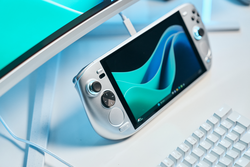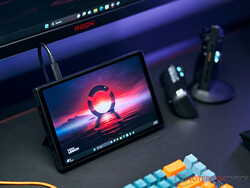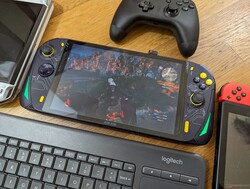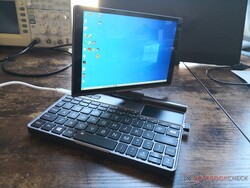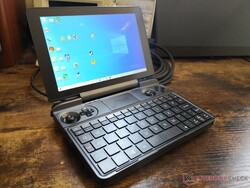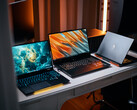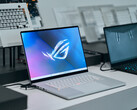Gaming handhelds are portable mini PCs which have been specially designed for playing video games. They combine a classic PC's compatibility with gaming-specific features found in a portable games console. Just like a laptop or tablet, they have an integrated display as well as a battery which supplies the device with power when you're out and about. Due to their ultra-mobile orientation, they possess a processor and graphics chip which have particularly low energy requirements similar to integrated graphics solutions. The performance achieved here is sufficient for the installed display to even manage to hit smooth frame rates playing current PC games in FHD and QHD+ resolutions with adapted settings.
These devices often do without a conventional keyboard and, instead, players are offered a button and joystick layout similar to a gaming controller. This means games can be played directly on the console without the need for additional input devices. Usually, a touchscreen is also on board and this can be used for control-based tasks and entering text. Since these handhelds are normally based on Windows, you can also use productivity software and, by connecting external input devices and a monitor, office use also becomes a reality.
In the following overview, we list the highest-rated gaming handhelds we have reviewed to date. The detailed individual reviews are linked accordingly.
Die besten Gaming Handheld PCs im Test (new v8 Rating)
Image | Model / Review | Price | Display | Weight | Dimensions |
|---|---|---|---|---|---|
| MSI Claw 8 AI+ Intel Core Ultra 7 258V ⎘ Intel Arc Graphics 140V ⎘ 32 GB Memory, 512 GB SSD | Amazon: 1. $1,624.21 MSI Handheld Claw 8 AI+ A2VM... 2. $9.99 TQLGY 2 Pack Tempered Glass ... 3. $599.99 MSI Claw A1M PC Gaming Handh... List Price: 999€ | 8.00" 1920x1200 283 PPI IPS | 793 g | 126 x 299 x 30 mm | |
| Asus ROG Ally X AMD Ryzen Z1 Extreme ⎘ AMD Radeon 780M ⎘ 24 GB Memory, 1024 GB SSD | Amazon: $549.22 List Price: 899€ | 7.00" 1920x1080 315 PPI IPS | 685 g | 111 x 280 x 36.9 mm | |
| ONEXPLAYER X1 Pro GA15H-HX370-32GB-1TB-H AMD Ryzen AI 9 HX 370 ⎘ AMD Radeon 890M ⎘ 32 GB Memory, 1000 GB SSD | 10.95" 2560x1600 276 PPI IPS | 928 g | 164 x 253 x 15 mm | ||
| Zotac ZGC-G1A1W-01 AMD Ryzen 7 8840U ⎘ AMD Radeon 780M ⎘ 16 GB Memory, 512 GB SSD | Amazon: 1. $12.99 Vaxson 3-Pack Screen Protect... 2. $12.98 Puccy 3 Pack Screen Protecto... 3. $25.99 PowerHOOD 65W USB-C AC/DC Ad... | 7.00" 1920x1080 315 PPI OLED | 692 g | 115 x 285 x 35 mm | |
| MSI Claw Intel Core Ultra 7 155H ⎘ Intel Arc 8-Core iGPU ⎘ 16 GB Memory, 1024 GB SSD | Amazon: $534.00 List Price: 849€ | 7.00" 1920x1080 315 PPI IPS | 672 g | 117 x 294 x 33 mm | |
| Ayaneo Flip KB AMD Ryzen 7 8840U ⎘ AMD Radeon 780M ⎘ 32 GB Memory, 2048 GB SSD | Amazon: 1. $19.89 PowerHOOD AC USB-C Power Ada... 2. $12.99 Vaxson 4-Pack Screen Protect... 3. $12.98 Puccy 4 Pack Screen Protecto... List Price: 1020€ | 7.00" 1920x1080 368 PPI IPS | 650 g | 108 x 180 x 37.5 mm | |
| GPD Win Mini 2024 7" AMD Ryzen 7 8840U ⎘ AMD Radeon 780M ⎘ 32 GB Memory, 512 GB SSD | Amazon: List Price: 1000 USD | 7.00" 1920x1080 315 PPI IPS | 526 g | 109 x 168 x 26 mm |
Note: We have recently updated our rating system and the results of version 8 are not comparable with the results of version 7. For this reason, we are temporarily running two separate top lists. Further information can be found here available here.
Die besten Gaming Handheld PCs im Test (old v7 Rating)
Image | Model / Review | Price | Display | Weight | Dimensions |
|---|---|---|---|---|---|
| ONEXPLAYER 2 Pro AR18 AMD Ryzen 7 7840U ⎘ AMD Radeon 780M ⎘ 32 GB Memory | Amazon: List Price: 1017 USD | 8.40" 2560x1600 IPS | 876 g | 135 x 311 x 43 mm | |
| Ayaneo Kun AMD Ryzen 7 7840U ⎘ AMD Radeon 780M ⎘ 64 GB Memory, SSD | Amazon: 1. $19.95 BoxWave Screen Protector Com... 2. $19.95 BoxWave Screen Protector Com... 3. $22.95 BoxWave Cable Compatible wit... List Price: 999€ | 8.40" 2560x1600 359 PPI IPS | 942 g | 140 x 325 x 22 mm | |
| Lenovo Legion Go AMD Ryzen Z1 Extreme ⎘ AMD Radeon 780M ⎘ 16 GB Memory, 512 GB SSD | Amazon: List Price: 800€ | 8.80" 2560x1600 343 PPI IPS | 845 g | 131 x 299 x 41 mm | |
| Ayaneo Air 1S Retro Power AMD Ryzen 7 7840U ⎘ AMD Radeon 780M ⎘ 32 GB Memory, 2048 GB SSD | List Price: 975€ | 5.50" 1920x1080 401 PPI OLED | 443.8 g | 90 x 224 x 21 mm | |
| Aokzoe A1 AMD Ryzen 7 6800U ⎘ AMD Radeon 680M ⎘ 16 GB Memory | Amazon: List Price: 1000 USD | 8.00" 1920x1200 283 PPI IPS | 735 g | 125 x 285 x 21 mm | |
| GPD Pocket 3 Intel Core i7-1195G7 ⎘ Intel Iris Xe Graphics G7 96EUs ⎘ 16 GB Memory, 1024 GB SSD | Amazon: List Price: 1000 USD | 8.00" 1920x1200 283 PPI IPS | 730 g | 137 x 198 x 20 mm | |
| GPD Win Max 2021 AMD Ryzen 7 4800U ⎘ AMD Radeon RX Vega 8 (Ryzen 4000/5000) ⎘ 16 GB Memory, 512 GB SSD | Amazon: List Price: 1000 USD | 8.00" 1280x800 189 PPI IPS | 850 g | 145 x 207 x 26 mm | |
| Valve Steam Deck 1 TB OLED AMD Steam Deck OLED APU ⎘ AMD Radeon Steam Deck 8CU ⎘ 16 GB Memory, 1024 GB SSD | Amazon: $659.97 List Price: 679€ | 7.40" 1280x800 204 PPI OLED | 640 g | 117 x 298 x 49 mm |
The table above shows an overview of the best Mini PCs tested by Notebookcheck. If the rating is the same, more recent tests are ranked first. The sales prices shown in the table and in the price comparison for the individual items are automatically updated daily and may therefore vary!
Link: all tested devices in this class
Editorial comment
In this overview, we will focus on Windows-based gaming handhelds. In addition to these, there are also some ARM-based devices or handhelds that use Linux as their OS. These include, among others, the Razer Edge or the Valve Steam Deck which we have also already tested. When it comes to ultra-mobile gaming, you could also consider selected smartphones. Examples of phones with a special focus on gaming would be the Asus ROG Phone 8 and the RedMagic 9 Proour extensive tests are linked in each case.
Many gaming handhelds have to be purchased via import. It is important to note that import sales tax, customs duties and possibly high shipping costs are due in addition to the purchase price. You should also bear in mind that warranty processing may be more difficult with these devices.
MSI Claw 8 AI+
MSI has relied on Intel chips for the Claw handhelds right from the start. This did not exactly prove to be advantageous for the first devices in the series. Even though Intel Meteor Lake processors offered a decent iGPU, AMD's Radeon RX 780M was clearly better. However, Intel has now made up for this. The Arc 140V in the Lunar Lake chips is potent and therefore the biggest criticism of the MSI Claw series is no longer applicable, at least in the new MSI Claw 8 AI+. The handheld is convincing in the current test report and is only criticized for its price.
Higher gaming performance (also compared to the ROG Ally X), lower consumption and longer battery life - the upgrade to the MSI Claw 8 AI+ is a success.
The feel and controller are good and the 120 Hz screen with variable frame rate is also a successful upgrade. MSI only needs to improve the companion software. In our test it proved to be a little laggy.
Asus ROG Ally X
Asus has listened to the criticism of the Asus ROG Ally to heart. Not much has been changed in the new Ally X has not been tweaked in terms of pure system performance. The AMD Ryzen Z1 Extreme still beats at the heart of the gaming handheld. The screen of the handheld is also unchanged from its predecessor. However, Asus has made significant improvements to the ergonomics, battery life and connections. And it's worth it. Under the same conditions, the new Ally X's battery now often lasts twice as long as its predecessor. In terms of battery life, the handheld from Asus is the best of the comparison devices. The feel and workmanship are excellent. Despite all the improvements, the handheld has not really become any heavier.
More power, a more pleasant feel and, in particular, significantly longer battery life. Asus has solved almost all of the ROG Ally's problems.
However, with an RRP of just under 900 euros, the Ally X is also one of the more expensive devices in the comparison. The device can currently be pre-ordered from Asus at https://rog.asus.com/de/gaming-handhelds/rog-ally/rog-ally-x-2024/. The handheld will be delivered from 26.07.2024.
OneXPlayer X1 Pro
The largest handheld in the comparison can also serve as a full-fledged laptop or tablet. The OneXplayer X1 Pro blurs the boundaries between these three device classes. An AMD Ryzen AI 9 HX 370 paired with 32 GB RAM impresses with its inner values. This means that even the latest titles can be played smoothly. Without upscaling, the Radeon RX 890M in the AMD chip cannot display all games smoothly on the 2.5 K screen, but Full HD still looks good on the 10.95 inch X1 Pro.
XL gaming handheld, tablet and laptop - the OneXplayer X1 Pro serves many needs.
If the controllers are not needed, they can be easily removed. The same applies to the good magnetically attached keyboard and the kickstand. Nevertheless, the gaming handheld with its 11 inch (approx. 28 cm) screen diagonal is no lightweight. The 929 gram weight of the X1 Pro but also a powerful battery. This provides around ten hours of streaming and surfing or around two hours of gaming AAA titles.
Price and availability
The OneXplayer X1 Pro is available directly from the manufacturer at https://bit.ly/41D3ApP. The test configuration, equipped with 32 GB RAM and 1 TB SSD, costs around 1,250 euros. A discount can be obtained with the coupon code NBCX1PRO.
The OneXplayer X1 Pro is also available from other retailers such as Geekbuying - often at special offer prices starting at around €1,050.
Zotac Gaming Zone - Zotac ZGC-G1A1W
The Zotac Zone is a gaming handheld that impresses with its high-quality OLED display, powerful AMD Ryzen 7 processor and precise controller. It offers a unique feel that can also be customized. The workmanship of the case is first-class and the ergonomics well thought out. Despite the powerful hardware, the device remains pleasantly quiet thanks to efficient cooling.
Points of criticism are the comparatively short battery life and the somewhat rudimentary software. The speakers also do not deliver an outstanding sound.
Overall, the ZOTAC Zone is a convincing handheld PC that will primarily appeal to gamers who value haptics, performance and a high-quality display.
Ayaneo Flip KB
The Ayaneo Flip is particularly compact thanks to its folding screen. Ayaneo has developed a special input concept for the Flip KB, which turns the gaming handheld into a mini laptop thanks to the keyboard. But Ayaneo also offers the handheld as a Flip DS. In this case, the keyboard gives way to a second screen. For retro enthusiasts in particular, this should open up interesting possibilities for bringing old Nintendo DS games to life on new hardware.
The Flip KB delivers a balanced performance in our test. The handheld's large and bright screen is particularly impressive. The Ryzen 7 8840U also delivers its usual good performance here. Even though Ayaneo relies on liquid metal for the cooling system, we can't detect any special results on the Flip KB.
MSI Claw A1M
The MSI Claw gaming handheld is not entirely convincing in the test. Despite the Intel Meteor Lake processor, the performance is worse than that of AMD handhelds and the cooling is very busy. The joysticks, buttons and gaming software are positive features. The 7-inch screen is acceptable, but an additional USB port would be desirable. Replacing the M.2-2230 SSD is complicated and requires dismantling the cooling system.
The high price of 850 euros is another disadvantage, especially in comparison to cheaper and more powerful alternatives such as the Legion Go and the ROG Ally. MSI has already announced a successor with a larger screen and a more efficient Intel Lunar Lake processor, but this is still a few months away.
MSI is not (yet?) backing the right horse with Intel, the Claw remains inferior in many aspects.
The starting price of around 850 euros for the MSI Claw seemed a little high. During Amazon Prime Days, however, the device was already available for only around 500 euros and could therefore definitely find one or two interested parties.
GPD Win Mini (2024) G1617
The GPD Win Mini stands out from other gaming handhelds with its folding design and integrated keyboard, making it more travel-friendly and versatile. Despite its compact size, it offers good case rigidity and battery life. The build quality, display and core specifications are competitive with models from Asus, Lenovo and others. However, in terms of gaming performance and ergonomics, it does not reach the level of cheaper models such as the Steam Deck or ROG Ally.
CPU and GPU performance is slower, and comfort during prolonged use leaves a lot to be desired due to the unconventional design. Additional detachable handles are available, but external controllers could be a solution. Other weaknesses include the loud fan noise and sometimes unstable frame rates. The high price of around 1,000 euros is a significant disadvantage, especially when compared to faster and cheaper alternatives.
Thanks to its unconventional design, the GPD Win Mini allows for versatile use, but does not reach the level of cheaper and sometimes faster devices in terms of gaming-relevant ergonomics and performance.
The GPD Win Mini 2024 with the Ryzen 8840U is currently available in Germany via Amazon.
One-Netbook OneXPlayer 2 Pro AR18
The OneXPlayer 2 Pro is a versatile gaming handheld that performs better in terms of battery life, sound and connectivity than the well-known Lenovo Legion Go, for example. One disadvantage is the less bright screen. However, the integrated keyboard and optional stylus turn the device into an ultra-compact laptop or tablet. The detachable controllers are less useful as they have no independent connection to the tablet, but they also work on other PCs.
The high price of 1,017 US dollars (approx. 940 euros) is a disadvantage, especially when compared to cheaper alternatives such as the Legion Go or the ROG Ally. However, the OneXPlayer 2 Pro offers a larger SSD, more RAM and a keyboard. Overall, the device is versatile, but the price could be a deterrent.
Gaming handheld or mini laptop, the OneXPlayer 2 Pro offers interesting application possibilities.
The OneXPlayer store is asking around 1000 euros for the versatile device, a lot of money for a gaming handheld.
Ayaneo Kun
The Ayaneo Kun is a powerful gaming handheld that is superior to the Lenovo Legion Go in many areas. It offers extreme performance, a bright screen, excellent controllers, a long-lasting battery and good sound. The quality of the casing and the modular design are also plus points. However, the Ayaneo Kun is more expensive, as it has to be imported and additional import sales tax applies, which increases the price to around 1,200 euros. In comparison, the Legion Go costs around 800 euros.
For pure gaming, the differences between the two devices are small, with the Legion Go possibly performing slightly better thanks to its 144 Hz display. The Ayaneo Kun is better suited as a desktop replacement and offers more configuration options. It is ideal for hobbyists who want to customize their hardware. However, if you are looking for an easy-to-use device, the Legion Go or the Asus ROG Ally Z1 Extreme may be a better choice.
The Ayaneo Kun is a powerful, large and attractively designed gaming handheld. However, competing devices also offer impressive performance.
The cheapest configuration of the Kun is available at in the Ayaneo store for around 1,000 euros.
Lenovo Legion Go
The Lenovo Legion Go impresses with its ergonomics and design as well as strong performance thanks to the AMD Ryzen Z1 Extreme and Radeon 780M iGPU. The 144 Hz display and the FPS mode are additional plus points. However, the short battery life is disappointing compared to competitor devices such as the ROG Ally and Ayaneo Kun. Other points of criticism include the wobbly stand, inconveniently placed speakers and observed software problems with Legion Space.
In terms of computing power, Ayaneo Kun and Asus ROG Ally are superior. Smaller and lighter alternatives such as Ayaneo Air 1S or more versatile devices such as OneXPlayer 2 offer additional options. For users with a large Steam library or knowledge of Linux, the Steam Deck remains an attractive choice.
The Lenovo Legion Go is a powerful gaming handheld, but also has some weaknesses compared to the competition.
The Lenovo Legion Go is currently available on Amazon for around 700 euros.
Ayaneo Air 1S Retro Power
The Ayaneo Air 1S Retro Power impresses in the test with a bright OLED display, a powerful AMD Ryzen 7 7840U and a sturdy casing. RGB lighting and excellent control software round off the device. However, the compact form factor comes with limitations, such as a small battery and screen, which limit the full potential of the pocketable handheld. On the go, you want more battery life, at home you want more power or a larger screen. Despite high surface temperatures, the device can maintain its performance.
The 5.5-inch OLED panel impresses with its high brightness, color gamut coverage and fast response times. The handheld copes well with games in Full HD resolution with low to medium settings. The input devices are well positioned and offer precise control. Overall, the Ayaneo Air 1S is a powerful, compact gaming handheld that is, however, limited by high temperatures and short battery runtimes. Compared to the larger Asus ROG Ally Z1 Extreme, it shows weaknesses.
The Ayaneo Air 1S is a particularly compact gaming handheld with a powerful AMD Ryzen 7 and fast iGPU.
The handheld can be purchased directly from the manufacturer and costs around 900 euros in the basic version https://ayaneo.com/goods/8230104170741 .
Aokzoe A1
The Aokzoe A1 offers impressive performance for its compact size thanks to the Ryzen 7 6800U. However, there are weaknesses in the hardware and features, such as hard-to-press shoulder buttons, intermittently loud fans and problems waking up from sleep mode. The display quality suffers from poorly calibrated colors and limited outdoor visibility.
Despite its good performance, the A1 lacks the refinements you would expect from a $1,000 device. Improvements such as better buttons, a brighter display and optimized fan behavior would be desirable. The A1 is a good choice for users looking for a large 8-inch touchscreen and consistent performance. However, devices like the Asus ROG Ally, which costs a similar amount, often offer better value and performance.
While the Aokzoe A1 is impressive in terms of performance, the device often lacks the care one would expect from a $1,000 gadget.
Starting at around 500 US dollars, the Aokzoe A1 is available on Amazon.com.
GPD Pocket 3
The GPD Pocket 3 is a versatile and powerful ultraportable system from 2021. It offers a smooth-running keyboard, numerous ports and a bright display. To use the full performance of the Tiger Lake U CPU, the higher performance limit should be activated in the BIOS.
The Pocket 3 impresses in terms of productivity, ergonomics and user-friendliness and offers similar performance to larger laptops. There is room for improvement in the rotating hinge, the asymmetrical webcam positioning and the tinny speakers. PCIe4 SSD performance is throttled by poor heat dissipation, and the slow charging speed is unexpected given the low battery capacity. A second USB-C port would increase versatility for docking purposes.
The Pocket 3 is GPD's most outstanding product to date in terms of productivity, ergonomics and usability.
The GPD Pocket 3 is still available on Amazon, but at a hefty price of around €1,250.
GPD Win Max 2021
This concept of a Windows 10 UMPC for 720p gaming is promising, but now dates back to 2021 and is therefore no longer quite up to date. The casing of the Win Max is in need of optimization: It creaks, the joysticks have a small range of movement, the touchpad is jerky, it lacks an integrated webcam and the microSD reader doesn't work. The WLAN is slow, DP-over-USB is not supported and the display is more in the budget range.
However, the performance is strong and comparable with Tiger Lake ultrabooks. The long battery life, the quiet fan noise outside of Turbo mode and the satisfactory key feedback are also positive features. For maximum gaming performance, the Core i7 version is recommended, while the Ryzen 7 SKU is ideal for multi-threaded CPU performance.
The performance is impressive and comparable to Tiger Lake ultrabooks, but the hardware and display still need some fine-tuning.
Amazon still lists the GPD Win Max 2011 for around 1,200 euros.
Steam Deck OLED
Valve's Steam Deck is to a certain extent the archetype of modern gaming handhelds. With the Steam Deck OLED was the first time that Valve made significant updates to the system last year. The Steam Deck does without Windows and is delivered with an Arch Linux specially adapted for gaming. However, this does not mean that the Steam Deck is not Windows-compatible. Valve offers all the necessary drivers and programs for installing the operating system for download. With a correspondingly large SSD, even a dual-boot configuration would be conceivable. On the hardware side, Valve reduces the Steam Deck to the essentials. The handheld offers no RGB, only 1290 x 800 pixels on the OLED screen and just one USB 4 port. Thanks to the widespread use of the handheld, both replacement parts and accessories for the Steam Deck are easy to obtain. Modders also get their money's worth.
In terms of performance, the Steam Deck's processor and iGPU lag behind the competition with Ryzen 7 7840U and comparable processors. However, the AMD Steam Deck OLED APU is perfectly adequate in combination with the HD+ screen in the Steam Deck. This results in respectable frame rates in many current titles. Ultimately, the APU has the advantage that it can work comparatively energy-efficiently. This means that the battery can last for several hours of gaming.
The performance of Valve's handheld is well balanced. The input devices, the sound and the OLED screen on the Steam Deck OLED are excellent.
With an OLED screen, the handheld is available from Valve from 570 euros. The Steam Deck is therefore comparatively inexpensive.
Benchmarks
| CrossMark - Overall (sort by value) | |
| ONEXPLAYER 2 Pro AR18 | |
| Ayaneo Kun | |
| Ayaneo Air 1S Retro Power | |
| Aokzoe A1 | |
| 3DMark 11 - 1280x720 Performance Physics (sort by value) | |
| ONEXPLAYER 2 Pro AR18 | |
| Lenovo Legion Go | |
| Ayaneo Air 1S Retro Power | |
| Aokzoe A1 | |
| GPD Pocket 3 | |
| GPD Win Max 2021 | |
3D performance
| 3DMark 11 - 1280x720 Performance GPU (sort by value) | |
| ONEXPLAYER 2 Pro AR18 | |
| Ayaneo Kun | |
| Lenovo Legion Go | |
| Ayaneo Air 1S Retro Power | |
| Aokzoe A1 | |
| GPD Pocket 3 | |
| GPD Win Max 2021 | |
| Average AMD Radeon 680M (6858 - 11755, n=37) | |




